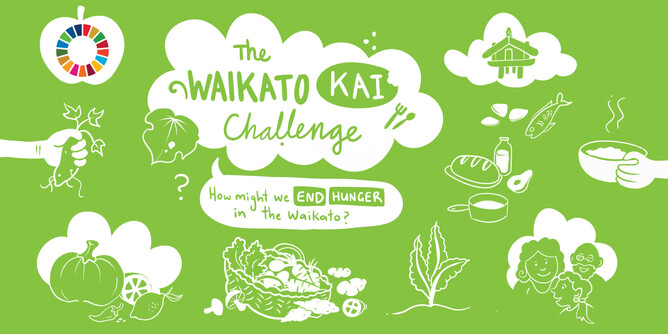The Waikato Kai Challenge is our initiative to understand how we might end hunger in the Waikato using our operating model, adapted and led by our manu taki.
The WWP has a target of reducing the number of children who live below the poverty line in the Waikato from about 17% to zero by 2030. We know that the answers to our kai challenges often already exist, and will also require systems change. During Covid, Māori communities led the response and ensured the distribution of kai. And our Pacifica communities are expert kai growers with a number of amazing gardens in Kirikiriroa. These are just a couple of examples and there are many more which we aim to uncover, uplift, support and look to scale up and out through our project.
We know that the challenge around access to good quality kai is significant and growing. According to the Child and Youth Wellbeing Strategy Annual Report, 15% of children (aged 0-14 years) across New Zealand live in households where food runs out sometimes . For Māori it is 26% and 37% for Pacifica.
Food insecurity is more prevalent amongst Māori children (2.5 times the rate for non-Māori), Pacific children (3.2 times the rate for non-Pacific), and children in areas of high socioeconomic deprivation (6 times the rate for lowest socioeconomic deprivation).
Our SDG1/2 Manu Taki Norm Hill, Ioana Manu (Hamilton City Council), Anna Casey-Cox (Poverty Action Waikato) and Cilla Abbott (MSD) are facilitating the conversation about how to dramatically reduce hunger and food insecurity in what is the food bowl of New Zealand. We know that every day hundreds of people and whanau in the Waikato rely on food charities and food organisations to assist them with meals and the dignity of supporting their whanau, a number that has been growing rapidly first due to the impact of COVID-19, but now also as inflation, fuel and other costs have pushed kai to the bottom of the essentials that can be afforded each week. We also know that for a sizeable proportion of the population (perhaps as much as 20%), even though they are employed, supermarket prices prevent healthy choices and force choices based on a full belly at least cost.
The approach to this challenge takes the WWP’s overall operating model and frames this within a matauranga Māori approach to kai and kai sovereignty, specific for the Waikato and the kai opportunities we have, expressed through the kaupapa of Rongomātāne Kai Māori – Kai Ora.
Our manu taki have been listening to the voices of those who experience food poverty, as well as sharing and celebrating the stories of communities who are finding ways to both feed their whanau, restore mana and knowledge about food cultivation, caring for the land and enhancing community connections.
An on-line hui on 22 June was hosted by our manu taki - you can watch a video from the hui below.
The hui introduced Rongomātāne Kai Māori – Kai Ora, hosted Joyce Maipi from the Matawhaanui Trust Community Garden in Rahui Pokeka, as well as Professor Arthur Grimes from Victoria University. On 27 July we will hold a second on-line kai forum where we will hear from more local leaders at the front line of the Waikato kai challenge. For more information contact Norm Hill (norm@tehira.co.nz ).


